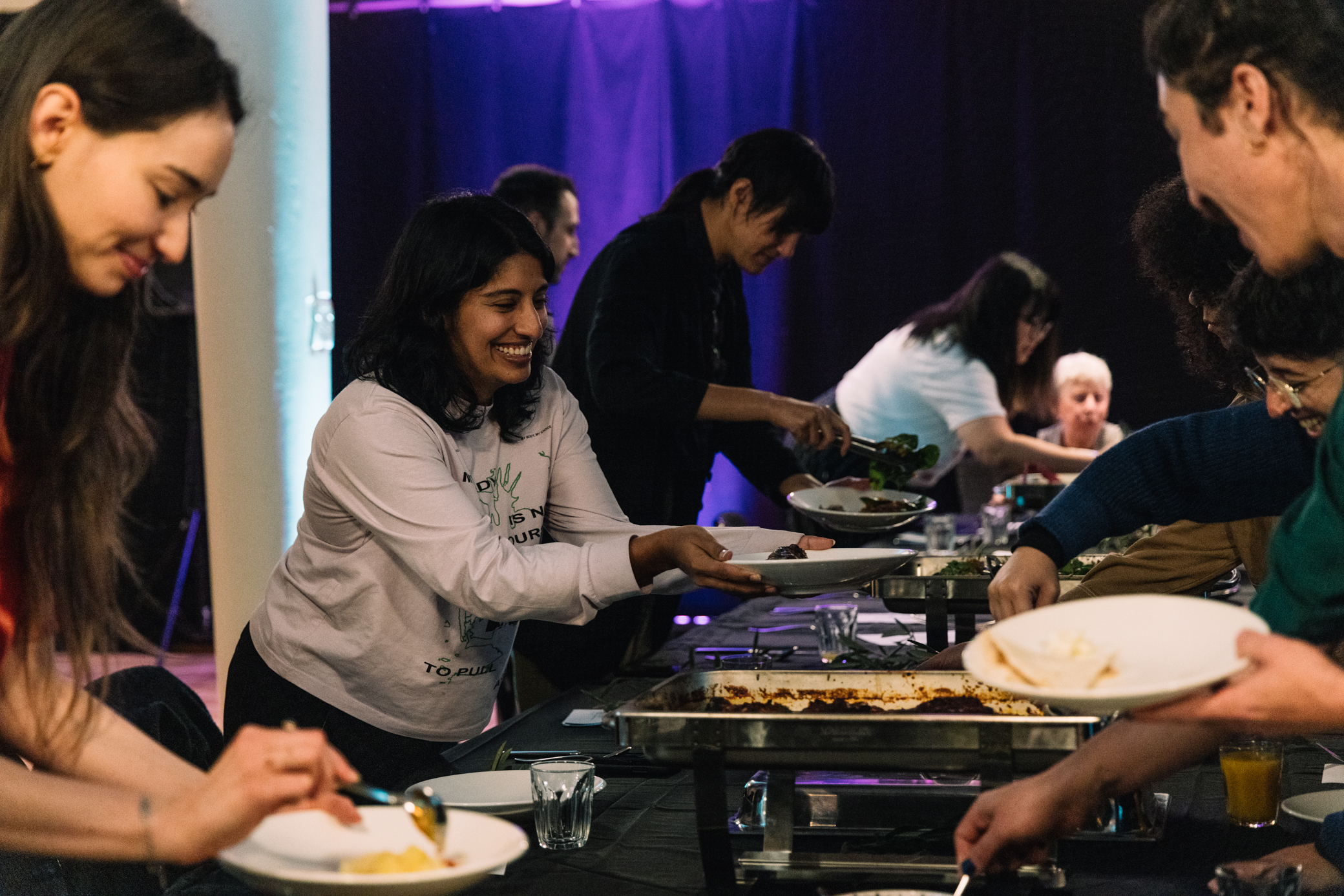An intersection of critique and praxis
Opening night remarks from Nithya Nagarajan
Okkoota ಒಕ್ಕೂಟ opened on 12 April 2023. Below are the opening night remarks from Co-Artistic Director, Nithya Nagarajan.
Okkoota, a Kannada word meaning ‘assembly, gathering, alliance’ is part of Arts House’s Equity—Builder, where an artist-curator from a marginalised community is handed over the keys, spaces and resources for a curatorial project in an effort to renew the relationship between the institution and independents.
I invited Vishal Kumarasamy as a guest curator to think into this space with me when I was early in my days in this role – approximately 8 months ago, and before he’d ever set foot on this continent. It was an interventionist invitation – Arts House is not a white cube space.
Art’s relationship to the corridors of power such as these, particularly by bodies such as ours, are fraught. And they are further complicated in an architecture that is as colonial and as purpose-built as a town hall. In his bio, you might have read that Vishal Kumaraswamy is a Dalit artist-curator, and April is Dalit history month.
Before I go any further, I should offer a trigger warning that there are references to violence and intergenerational trauma in the show, and in this piece.
Dalit literally translates as ‘broken but resilient’ and is a self-determined term for people deeply oppressed by the caste system. Dalit communities were and continue to be forced into bonded agricultural labour, manual scavenging and other inhumane forms of slavery. In tandem with South Asia’s Adivasi communities, Indigenous communities, caste oppressed peoples face discrimination, violence and erasure at every structural level of society. Caste is a term you may have little to no familiarity with in this context. Caste is a hereditary and extreme form of social stratification. You inherit a certain caste location at birth that you cannot transcend in your lifetime and this is connected to ideas of labour, class, spiritual purity and directly impacts access to land, education, and basic civic and human rights. Caste system does not demarcate racial division.
Now why does it matter in Australia? Because it travels everywhere the diaspora go. There is somewhat of a reckoning happening with caste in the United States and the UK, but that hasn’t had ripple effects on this continent yet.
There are many reasons why caste does not garner the circulation and solidarity that other protected categories do, such as race, age, gender, sexuality etc. Some of the reasons are: a.) caste is an invisible indicator – you cannot look at a person and determine caste on the value of sight. So one of the purposes of this project was to make an invisible indicator, visible. And works from Kirtika Kain, Rahee Punyashloka and Subash Thebe Limbu do just that, in radical ways. b.) there is a wilful censure of the mention of caste and other persecuted minorities, particularly through the media, schooling and higher education systems. In the absence of freedom of speech, low literacy levels and high digital surveillance, misinformation cycles circulate. How do you archive the muffled silences of structural and sometimes state sanctioned violence? Moonis Ahmad, Nikhil Nagaraj and Shareeka Helaluddin respond in their works. c.) The outcome of speaking about caste in many parts of the subcontinent, and indeed the diaspora, can be punitive. There are assimilatory forces heightened in the condition of diaspora, who are often from the forward caste. A rudimentary analysis of the factors that enable cross-border and choice mobility will show you why. So it was important to us to amplify the voices of diaspora who are contending with disarticulated subjectivities such as in the practices of Sancintya Mohini Simpson, Phuong Ngo and Eddie Abd.
The general population have little to no discernment of the forces of harm inflicted on the Dalit body. When Vishal and I had long Zooms about this project, we talked about many things, including how representational rhetoric can make our houses both transparent and opaque. Vishal was clear that he wanted to seed and realise a project that isn’t representational. Vishal uses the emancipatory potential of anti-caste thinking to approach this question of gathering through a regenerative and redistributive frame.
Okkoota isn’t a show that is representational: neither does it comprise of artists solely from Dalit and caste oppressed backgrounds, nor does it describe or replicate the material experiences of people who belong to Other, Most, or Scheduled Castes and Scheduled Tribes of South Asian or diaspora communities. It is instead looking at the assembly of certain conceptual practices through an anti-caste lens. Of how just futures can be surfaced onto an imperial architecture. Of how civic spaces can be reimagined as third spaces, for that of gathering outside of the confines of home or work. Of how an exhibition can be a structural critique that the proposal can proceed from. Of how the deceptively simple, embodied, communal act of inter-dining – of eating together – demolishes hierarches inherited by the practice of caste endogamy. Of how an intimidating infrastructure such as this can posit speculatory possibilities.
Okkoota is Vishal’s way of framing the problem in this context as well as blunting the edges of the institution. It is an intersection of critique and praxis.
We invite you to wander and experience the works in the main hall, in the foyer spaces, in the two studios above on floor one that also lead you to the base of the clock tower.
I leave you with the words of a crusader for Dalit rights and a contributor to India’s constitution, Babasaheb Ambedkar, BR Ambedkar: ’A just society is that society in which an ascending sense of reverence and a descending sense of contempt is dissolved into the creation of a compassionate society”.


